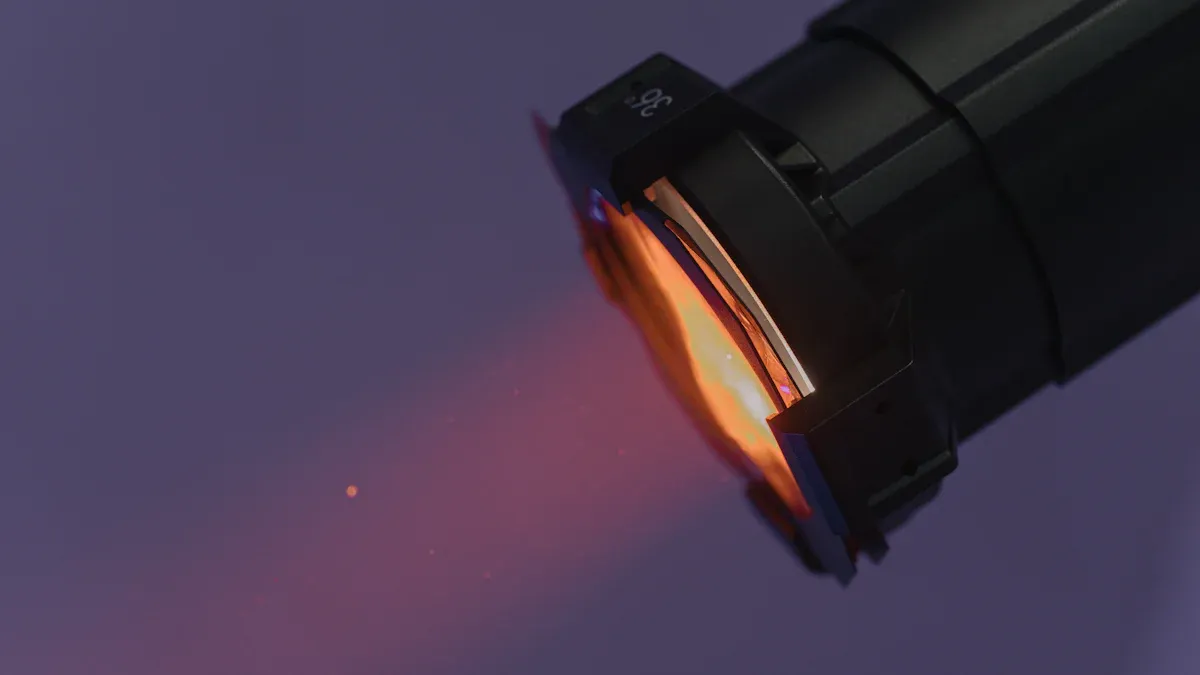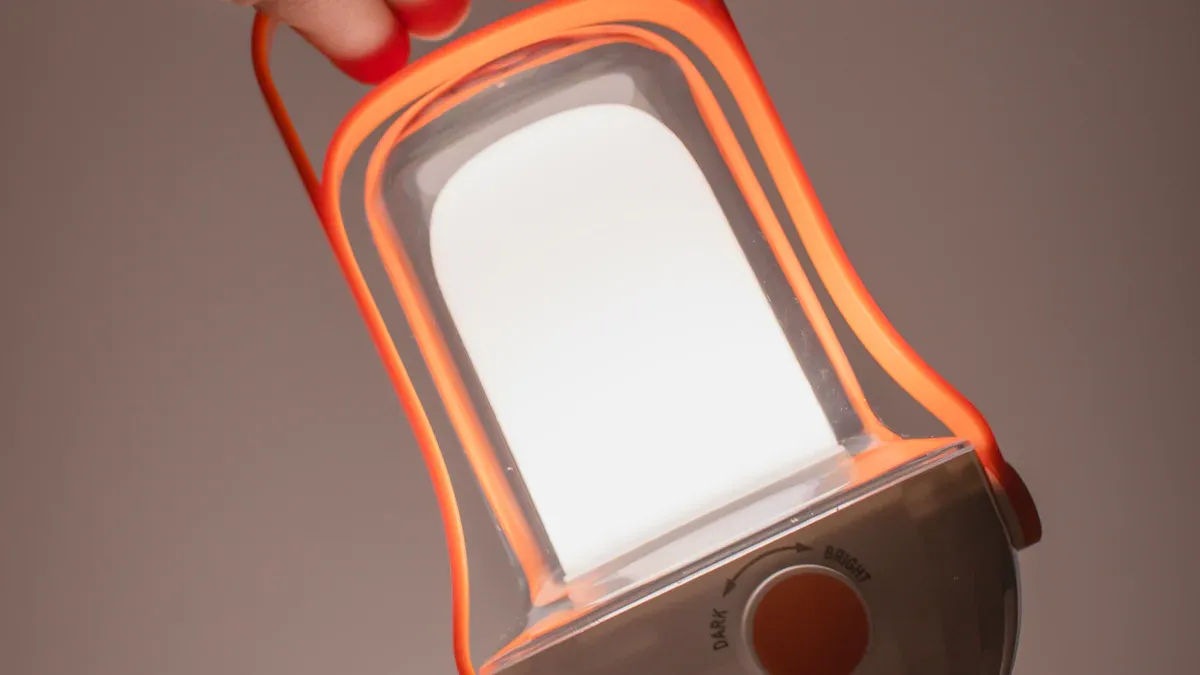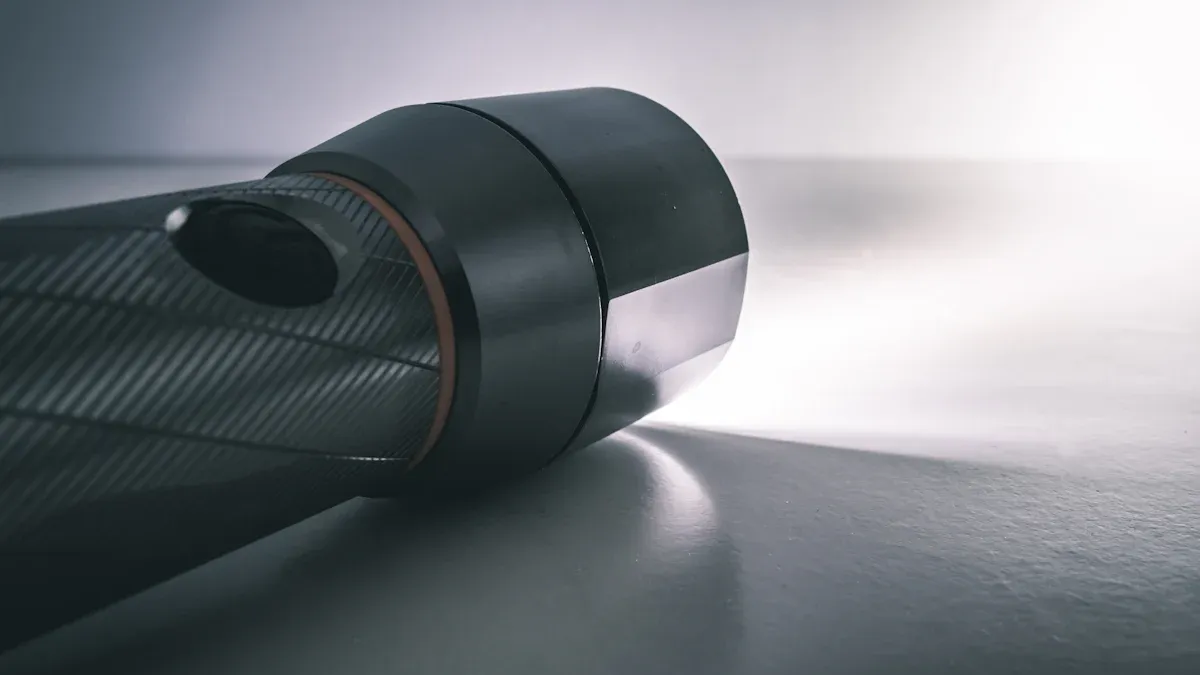How Battery Life Affects Your Flashlight Choice for Daily Use

When you’re picking a flashlight for daily use, battery life is a game-changer. It determines how reliable your flashlight will be when you need it most. A helius flashlight, for example, offers dependable performance thanks to its efficient battery. Choosing the right one ensures you’re never left in the dark when it matters.
Key Takeaways
Battery life is very important for flashlight use, especially in emergencies. Pick strong batteries like 18650 for reliable use.
For everyday use, choose rechargeable lithium-ion batteries. They cost less over time and need fewer replacements.
Change brightness levels to make batteries last longer. Use dimmer light when you don’t need full brightness to save power.
Why Battery Life Matters in a Flashlight

Reliability in emergencies
Imagine being stuck in a power outage or stranded outdoors at night. In these moments, a flashlight with dependable battery life becomes your lifeline. You need a flashlight battery that won’t fail when you need it most. A flashlight with high-capacity batteries, like 18650 models, offers the reliability you can count on. These batteries deliver consistent power and ensure the flashlight performs well during emergencies. Whether it’s a super bright flashlight or one with adjustable brightness, the right battery capacity can make all the difference.
Convenience for daily tasks
For everyday use, you want a flashlight that’s ready to go whenever you need it. Whether you’re searching for something in a dark corner or walking your dog at night, a flashlight with a long runtime saves you from frequent battery changes. Rechargeable lithium-ion batteries are a great option for daily tasks. They provide excellent performance and are easy to recharge when needed. Plus, flashlights with adjustable brightness settings let you conserve power for longer use. This convenience makes your flashlight a reliable tool for all kinds of daily activities.
Cost-effectiveness over time
Choosing the right flashlight battery can save you money in the long run. High-capacity batteries, like 18650 rechargeable options, reduce the need for constant replacements. While rechargeable batteries may cost more upfront, they offer better value over time. They also provide consistent power, ensuring your flashlight stays bright and functional. By investing in a flashlight with efficient battery capacity, you’ll enjoy better performance and lower costs over its life.
Factors That Influence Flashlight Battery Life
Brightness settings and modes
The brightness settings on your flashlight play a huge role in how long the battery lasts. High brightness levels drain the battery faster, while lower settings conserve power. Many flashlights come with multiple modes, like low, medium, high, and even strobe. If you use a flashlight with adjustable brightness, you can switch to a lower setting when you don’t need maximum light. This helps extend the runtime and ensures the flashlight is ready when you need it most. For example, LED flashlights on low settings can last up to 120 days, while high settings may only last a few hours. Choosing the right mode for the task at hand can make a big difference in battery performance.
Battery type and capacity
The type and capacity of the battery directly affect how long your flashlight will run. Higher-capacity batteries, like 18650 models, provide longer runtime but may be bulkier or more expensive. Here are some key points to consider:
Larger batteries, such as 18650s, generally have a higher capacity, allowing them to power the flashlight for a longer duration.
Rechargeable lithium-ion batteries offer excellent performance and are ideal for frequent use.
Battery life refers to how long the battery can power your flashlight before needing a recharge or replacement.
If you’re using high-performance tactical flashlights, investing in a battery with a larger capacity ensures better reliability and longer battery lifespan. This is especially important for tasks requiring consistent power, like outdoor adventures or professional work.
Frequency and duration of use
How often and how long you use your flashlight also impacts its battery life. If you use it daily for short periods, the battery will last longer compared to extended use. Here’s a quick look at average battery life based on usage:
Battery Type | Average Battery Life |
|---|---|
Alkaline | 1 to 7 hours |
Lithium-ion | Up to 650 hours |
LED (Low settings) | Up to 120 days |
LED (High settings) | 1.5 to 7 hours |
For daily tasks, a rechargeable flashlight with a long runtime is a smart choice. It ensures you won’t have to replace the battery frequently, saving you time and money. On the other hand, if you need a flashlight for emergencies, a model with a longer tactical flashlight lifespan is more suitable.
Types of Flashlight Batteries and Their Performance

Alkaline batteries: Pros and cons
Alkaline batteries are a common choice for flashlights due to their availability and affordability. You can find them almost anywhere, making them a convenient option when you need a quick replacement. They’re also compatible with many devices, so you might already have some at home. However, they come with a few drawbacks. Alkaline batteries have a lower power output compared to other types, which can limit your flashlight’s performance. They’re also bulkier and heavier, which might not be ideal for portable flashlights. If you’re planning to use your flashlight in extreme temperatures, alkaline batteries might not hold up well. Here’s a quick breakdown:
Advantages | Disadvantages |
|---|---|
Widespread availability | Lower power output |
Cost-effectiveness | Added weight and bulk |
Ease of replacement | Limited advanced features |
Compatibility with other devices | Potential performance issues in extreme temperatures |
Lithium-ion batteries: Pros and cons
If you’re looking for better performance and longer life, lithium-ion batteries are a fantastic choice. They have a higher capacity and can handle high-current devices like flashlights with adjustable brightness. These batteries also perform well in extreme conditions, making them perfect for outdoor adventures. On the downside, they’re more expensive upfront. However, their rechargeable nature makes them cost-effective over time. Let’s compare them to alkaline batteries:
Feature | Lithium-Ion Batteries | Alkaline Batteries |
|---|---|---|
Maximum Discharge Rate | Higher, suitable for high-current use | Lower, unsuitable for high-current use |
Operating Temperature Range | Wider range, ideal for extreme conditions | Limited range, affects performance |
Nominal Voltage | 3.7 volts | 1.5 volts |
Lifespan | 0.5-1 year | |
Price | $5-$10 per cell | $0.50-$1 each |
Environmental Impact | More eco-friendly, rechargeable | Single-use, creates more waste |
Rechargeable vs. disposable options
When choosing between rechargeable and disposable flashlight batteries, it’s important to consider your usage habits. Rechargeable batteries, like lithium-ion ones, are ideal for frequent use. They’re more eco-friendly and save you money in the long run. Disposable batteries, on the other hand, are better for occasional use or emergency kits. They’re easy to store but can leak if left unused for too long. Here’s a quick comparison:
Feature | Rechargeable Flashlights | Disposable Battery Flashlights |
|---|---|---|
Cost-effectiveness | Cheaper in the long run due to reusability | More expensive over time due to replacements |
More eco-friendly, less waste | Contributes to more waste and requires recycling | |
Storage issues | Long shelf life, always ready for use | Short shelf life, can leak if stored too long |
If you use your flashlight daily, rechargeable lithium-ion batteries are the way to go. They offer consistent power and better battery capacity, ensuring your flashlight is always ready when you need it.
Matching Flashlight Battery Life to Your Needs
Everyday carry (EDC) flashlights
When it comes to EDC flashlights, portability and reliability are key. You want a flashlight that fits easily in your pocket or bag while offering dependable performance. Here’s what to consider when choosing one:
Lumens and Brightness: Match the brightness to your daily tasks. A flashlight with adjustable brightness is ideal.
Battery Life and Power Source: Opt for a flashlight with a long battery life. Rechargeable options, like those using 18650 batteries, are perfect for frequent use.
Size and Portability: Compact designs make carrying your flashlight hassle-free.
Durability and Water Resistance: Look for rugged construction and IPX ratings to ensure your flashlight can handle everyday wear and tear.
Extra Features: Modes like strobe or SOS add versatility to your EDC flashlight.
A high-quality tactical flashlight with these features ensures you’re prepared for anything, whether it’s finding your keys or navigating a dark parking lot.
Outdoor and adventure flashlights
Outdoor activities demand a flashlight with exceptional battery capacity and durability. You need one that can handle extended use and harsh conditions. Here’s why battery life matters:
Long-lasting batteries ensure your flashlight stays reliable during hikes or camping trips.
Rechargeable batteries, like 18650 models, provide consistent power and reduce waste.
Extreme temperatures can affect battery performance. Keep your flashlight warm in cold weather and shaded in hot conditions.
Carrying spare batteries in insulated containers is a smart move. It ensures you’re never caught off guard, even in challenging environments.
Professional and work-related flashlights
For professional use, you need a flashlight that combines power, capacity, and reliability. Whether you’re working in construction, law enforcement, or maintenance, a flashlight with a robust battery is essential. Look for these features:
High-capacity batteries, like 18650s, for extended runtime.
Adjustable brightness settings to match the task at hand.
Durable designs that withstand tough conditions.
A flashlight with rechargeable batteries saves time and money, making it a practical choice for daily work. Choose a flashlight battery that aligns with your job’s demands to ensure consistent performance.
Tips to Maximize Flashlight Battery Life
Use appropriate brightness settings
Using the right brightness setting can significantly extend your flashlight's battery life. High brightness levels might seem tempting, but they drain the battery quickly. Instead, switch to lower settings when you don’t need maximum light. For example, if you’re reading a map or walking in a dimly lit area, a medium or low brightness mode works perfectly. Many flashlights, especially those powered by 18650 batteries, come with adjustable brightness modes. These allow you to balance power consumption and performance based on your needs. By choosing the appropriate setting, you’ll not only conserve battery capacity but also ensure your flashlight is ready when you need it most.
Store batteries properly
Proper storage plays a big role in maintaining battery life and durability. Always keep your batteries in a cool, dry place away from direct sunlight or extreme temperatures. Humidity can damage the battery cells, so avoid storing them in damp environments. Use their original packaging or a battery case to prevent contact with metal objects, which could cause short circuits. If you’re not planning to use your flashlight for a while, remove the batteries to prevent leakage or corrosion. For rechargeable lithium-ion batteries, store them at a partial charge (around 30%-50%) to preserve their capacity. These simple steps can help maintain your flashlight’s performance over time.
Opt for rechargeable batteries for frequent use
If you use your flashlight daily, rechargeable batteries are a smart choice. They offer consistent power and reduce waste compared to disposable options. While the initial cost of rechargeable batteries, like 18650 models, is higher, they save you money in the long run. Plus, they support sustainability by minimizing harmful chemical waste. Rechargeable lithium-ion batteries are particularly efficient, providing excellent capacity and durability. They’re perfect for frequent use, ensuring your flashlight delivers reliable performance whenever you need it. Switching to rechargeable options is an easy way to maximize battery life while being eco-friendly.
Choosing the right flashlight starts with understanding how battery life impacts its performance. You’ll want to match the battery type and capacity to your specific needs. For example:
Rechargeable batteries are ideal for frequent use, offering cost-effectiveness and environmental benefits.
Lithium batteries excel in cold climates, ensuring reliable performance outdoors.
By considering your usage patterns and the flashlight’s power source, you can make a smart choice that balances runtime, reliability, and convenience. Whether you need a flashlight for daily tasks or emergencies, selecting the right battery ensures it’s always ready when you need it.
FAQ
What flashlight battery size and compatibility should you consider?
You should check the flashlight's manual or specifications. Ensure the battery size and compatibility match the recommended type for optimal performance and safety.
Are high capacity batteries worth the investment?
Yes, they last longer and reduce the need for frequent replacements. High capacity batteries are ideal for flashlights used in emergencies or professional tasks.
How can you choose the right flashlight for daily use?
Focus on your needs. Look for features like adjustable brightness, rechargeable options, and durability. A flashlight with reliable battery life ensures consistent performance.
See Also
Maximize Your Flashlight's Battery Life With These Tips
Increase Your Flashlight's Lifespan For Extended Usage
Comparing Police Flashlights And Regular Ones: Which Wins?
